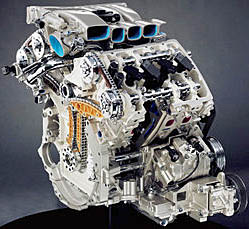W8
The W engine is an engine configuration in which the cylinder banks resemble the letter W in the same way a V engine resembles the letter V. There have been three entirely different implementations of this concept: one with three banks of cylinders, one with four and one with two banks of cylinders and two crankshafts.
The Original "three-bank" Design
The classical W engine uses three banks of cylinders, all connected to one crankshaft.
One of the first W engine was a W3, built by Anzani in 1906 to be used in their motorbikes. It is this W3 engine which also powered the Blériot XI, the aircraft used by Louis Blériot when on the 25th of July, 1909, he made the first ever successful flight across the English Channel.
The 1917 Napier Lion aircraft had a first W12 engine.
Later, a W12 design was also pursued by Audi, who later abandoned the project. However, the Volkswagen Group later built an experimental W18 engine for Bugatti's EB 118 and EB 218 concept cars, but the design was determined to be impractical because of the irregular firing order required by the three rows of six cylinders.
The Modern "four-bank" Design
The Volkswagen Group (VAG) created the first successful automotive W engine with the introduction of their W12. It combined two narrow-angle VR6 engines around a single crankshaft for a total of four banks of cylinders. For this reason, the four-bank configuration is sometimes, and more accurately, referred to as a "VV" ("vee-vee" or "double-vee") to distinguish it from the traditional three-bank "W" design.
The W-12 is used in the Volkswagen Phaeton, the Audi A8 and the Bentley Continental GT - though in the latter application, the engine has been highly modified by Bentley and fitted with twin KKK turbochargers. As a result, it produces considerably more power than the original version. The narrow (15°) angle between bank pairs makes this engine resemble a V12 in that it has just two cylinder heads and two sets of camshafts.
VAG went on to produce a W16 prototype which produced 623 horsepower (465 kW) for the Bentley Hunaudières concept car. A quad-turbocharged version of this engine went into production in 2005 powering the 1001hp Bugatti Veyron 16.4. A W8 engine was also produced for use in the VW Passat.
The major advantage of these engines is packaging, i.e., they contain high numbers of cylinders but are relatively compact.
The Motorcycle "two-bank" Design
A very rare type of W engine is found in motorbikes of the MotoGP class. These are 2-stroke, 500 cc V engines with two banks of two cylinders and two separate crankshafts, one per bank of cylinders, thus constituting a sort of "W" form. The angle between the banks varies from 60 to 75 degrees.
There are two major advantages of these engines over the more traditional straight-4 or V4 engines. The first is the width of the engine: a V4 engine will be narrower than a straight-4 engine with the same displacement, but a W4 with its two crankshafts will be even smaller. The second advantage is that the W4 lacks the need for a balance shaft; it will run smoothly if the two crankshafts rotate in opposite directions. This is a weight advantage over the V4 engine, which will need a balance shaft.
Examples of these type of W4 engines are the Yamaha Motor Corporation YZR500 and the Cagiva GP500 motorbikes.
These types of engines should not be confused with the U engine, which also has two banks of cylinders and two crankshafts, but which is made by combining two similar straight engines. The U engines lack the advantages the "W"-form of the engine has in terms of width and weight.
See also
External links
| Piston engine configurations | |
|---|---|
| Straight | Single, 2, 3, 4, 5, 6, 8, 9, 10, 12, 14 |
| V | 2, 4, 5, 6, 8, 10, 12, 16, 20, 24 |
| Flat | 2, 4, 6, 8, 10, 12, 16, H |
| W | 8, 9, 12, 16, 18 |
| Other inline | H, VR, Opposed, U (Square), X |
| Other | Hemi, Radial, Rotary, Pistonless, Deltic, (Wankel) |
| Heat engines | |
|---|---|
| Stroke cycles One • Two • Four • Six • | |
| Engine types Gas turbine • Piston • Jet • Rocket engine • Steam engine • Stirling engine • Tschudi• Twingle Rotary • Wankel • Free-piston • Britalus • Coomber • Swing-piston • Orbital • Quasiturbine | |
| Valves Cylinder head porting • D slide • Four-stroke • Manifold • Multi • Piston • Poppet • Sleeve | |
| Piston layouts Single cylinder • Straight • Opposed • Flat • V • W • H • Deltic • Radial • Rocket engine nozzle • Rotary • Stelzer • Controlled Combustion • Bourke | |
| Motion mechanisms Cam • Connecting rod • Coomber rotary • Crank • Crank substitute • Crankshaft • Linkages (Evans • Peaucellier-Lipkin • Sector straight-line • Watt) • Double acting/differential cylinder | |
| Thermodynamic cycle |
